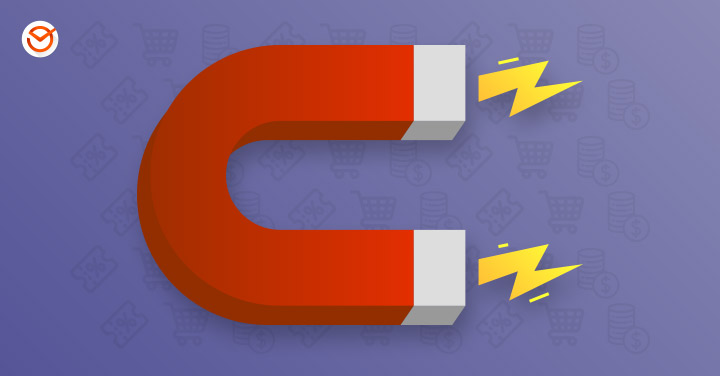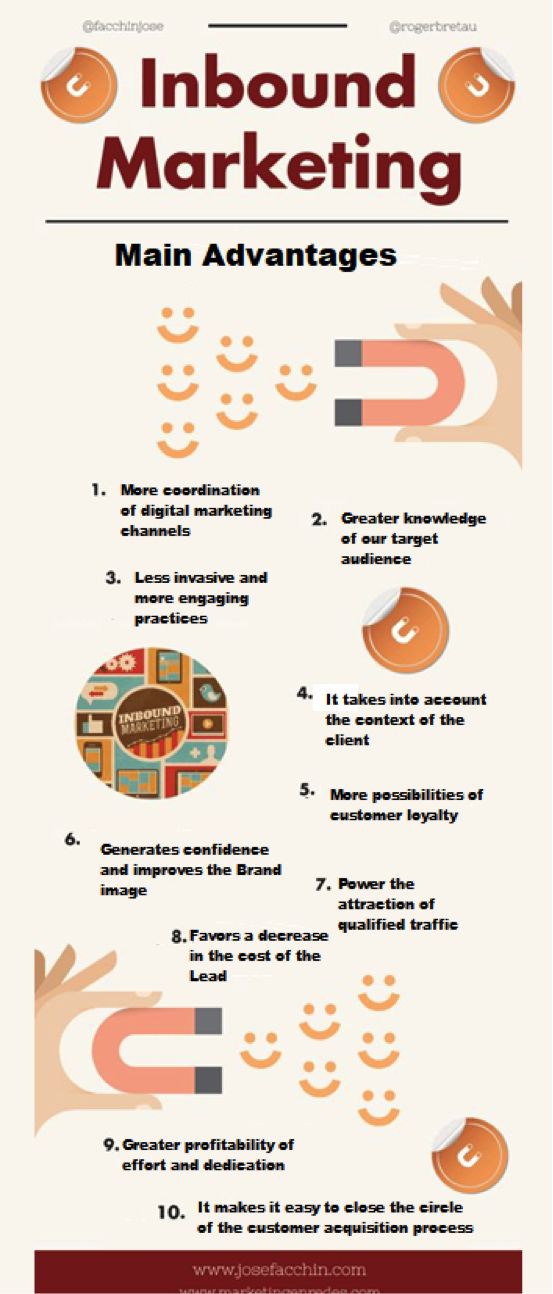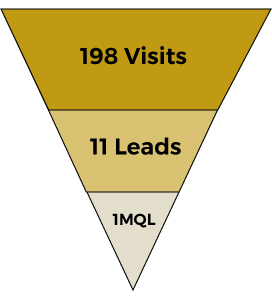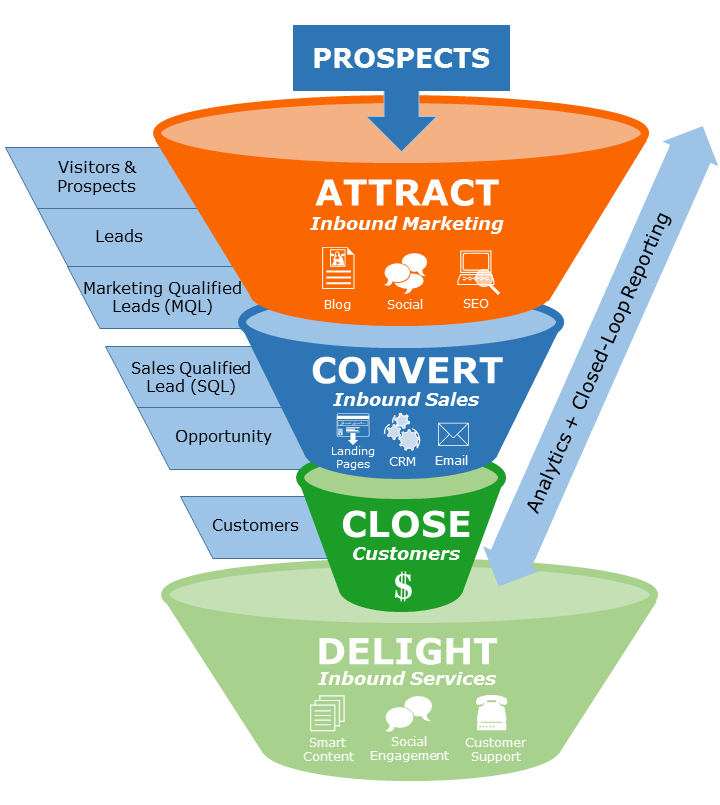
What Is The Inbound Marketing?
Inbound Marketing is a methodology that consists of 4 actions, which have in each, pillars and tools that provide results to companies.
The purpose of Inbound Marketing is that the person finds the brand from the process of Awareness (knowledge) and continues with it during the entire purchase process until it becomes a client.
The concept, as it is known today was coined in 2005 by Brian Halligan, co-founder and CEO of Hubspot. Although it was until 2009, which became popular, due to the book: Inbound Marketing: get found, using Google, Social Media and Blogs.
The methodology (as has been said) has 4 actions and is based on marketing and advertising techniques such as SEO, social media, content marketing, search engine advertising, etc.
Basic Terms of Inbound Marketing
To understand the Inbound methodology it is necessary to know three basic terms:
- Buyer’s Journey: is the process of buying of a user. It consists of three phases:
- Awareness (Conocimiento): at this phase, the user does not know anything about the brand and has not detected a problem or a real need.
- Consideration (consideración): It is in this phase when the user begins to become more aware of the need or problem he has, considering possible solutions.
- Decision (decisión): In here the person has evaluated possible solutions and is about to make a decision to solve their problem or need.
- Buyer persona: is the description of a fictional character that simulates the ideal customer of the brand. Integrates specific descriptions about your lifestyle, demographic, socioeconomic data, etc.
- Lead: is the person who decides to leave their data in a form on the website and is a possible potential customer.
Fact! In a typical Inbound Marketing strategy, an average of 198 visits are needed to generate 11 leads and 1 marketing qualified lead. (Source: InboundCycle)
The 5 pillars of Inbound Marketing
- Buyer Persona: They are to whom the strategies are directed. It is with them that you have to connect and communicate.
- Content Marketing: is the generation of valuable content, relevant and optimized for users to find the brand.
- Segmentation: is to group the users/clients according to certain particular characteristics, and to accompany each group in the purchasing processes (awareness, consideration, and decision).
- Marketing automation: use tools that help to do concrete and effective actions in less time. Through marketing automation ensures a message to the public at the right time and place.
- Analysis: With it being a digital marketing strategy, it makes it easily measurable to make improvements and make adjustments that allow offering better results.
The 4 actions of Inbound Marketing
- Attract: seeks to attract or attract the attention of users. For this, different tactics or tools are used, such as content marketing, blogs, SEO and social networks.
- Convert: in the conversion process, a user who does not know the brand is expected to become a lead. That is to say, in a potential client or person who is interested in having business or communication with the brand. In this action, you take the hand of tools such as CTA’s, Landing pages, content marketing, etc.
- Close: in this phase, the objective is to get that lead or potential client to close a sale with the company. For this, email marketing is mainly used.
- Captivate: not everything ends in the sale; the next step is to conquer those customers to provide good references on the brand and to return for more. Again email marketing and social networks play a fundamental role.
Data and Statistics on Inbound Marketing
According to the results of Inbound Marketing 2017:
- Inbound Marketing increases the qualified marketing contacts (MQL) of a company, multiplying by 7.3 in a year and by 9.8 in two years.
- In Inbound Marketing, organic and direct channels together represent 65% of visits, 52% of records and 53% of qualified marketing leads.
- An Inbound strategy is effective in companies of any sector. B2B companies experience a greater conversion from visit to registration and B2C presents a greater increase in accumulated visits. (Source: InboundCycle)
Relationship between Inbound Marketing and Social Networks: How to get the most out of it
In the Inbound Marketing methodology, social networks are an essential channel to achieve the results. The role of these media within marketing is synthesized in converting, visualizing, providing customer service and improving the reputation and image of the brand.
The success of social networks consists of taking the need of the human being to socialize, create communities and be connected to the world today; the digital and the internet.
Currently, there are many social networks, although the most famous are Facebook, Instagram, and Twitter.
Knowing more each social network
- Some facts about Facebook:
1) It has more than 1000 million users and every day that number increases.
2) 78% of people who use Facebook have contact with a company and some brand.
3) The growth of Facebook messenger currently has 1.3 million active users per month and continues to increase. With an estimated, 2.4 billion messages exchanged per month and a total of 70 million companies use it. - Twitter: is a social network of microblogging.
1) It has 600 million users,
2) 56% of users have contacted a company or brand despite only 140 characters, now the communication will continue with 280. - Instagram: It is a social network of images, it is 100% visual, hashtag and a little bit of text.
1) Currently, it has a Little bit more than 100 millions of users and there is a lot of potential for the industries of food, pets, etc. - LinkedIn: is professional, serious and with 200 million users is not enough because it keeps growing. The main objective is to generate networking.
- YouTube: who does not know this social network of videos that has reached 900 million users and there are still much more to reach. For an Inbound Marketing strategy, it is perfectly aligned, it is easy to integrate, spread the content on other social networks and have great reach.
How to use Social Networks to boost your Inbound Marketing strategy
Social networks are fundamental in different actions of the Inbound Marketing methodology.
70% of active Internet users use some type of social network according to the latest report from the Gartner consultancy. It is undoubtedly a fundamental pillar and an essential tool.
The traffic that exists in social networks allows to attract users and interact in a more friendly and human way with leads and customers since it allows us to create long-term relationships with our clients through the person-to-person dialogue. By doing this you can achieve reach, a better opening rate, a direct conversation, personal and bi-directional.
Did you know that 77% of consumers do not buy online if they do not have the possibility to chat with someone? (First person). Through social networks you can provide immediate communication. The average response is 42 seconds according to Zen Desk.
The combination of an Inbound Marketing methodology and social networks allows creating conversations that build lasting relationships. Although to achieve it you need creativity and knowledge, as well as community management tools, such as CRM, design, analytics, etc.
Hubspot, for example, gives a series of guidelines to integrate Inbound Marketing into Social Networks:
- To attract, it is advisable to include much more than commercial information about your brand and that people can find every day.
- In the conversion process, it is important to integrate links to landing pages and answer the questions or needs of the target.
- To close it is necessary to follow up on each comment, inbox, tweet, etc.
- Finally, to captivate or loyalty, the most advisable is to ratify your decision, provide recommendations, offer promotions, discounts, etc.
In all stages of the Inbound Marketing methodology, you can integrate social networks to move them in each stage and have buyers or users back.
The blog, mailing or SEO is not enough, but there is an integration of social networks to the Inbound strategy. It is the means that allows the diffusion and allows improving the position in search engines. The more content, more quality and more interactivity, the better results.
Inbound Marketing and social networks have an inseparable friendship, and that is why they must walk together with a plan and a vision that leads companies to take off. Today’s digital marketing recommends it, but the public is the one who sets the tone and demands it.
_______________
About the Author
 Sophia Valenzuela is a copywriter at MAS Digital. She is a marketer and economist, she likes social media, and she is interested in neuromarketing, entrepreneurship, and finances.
Sophia Valenzuela is a copywriter at MAS Digital. She is a marketer and economist, she likes social media, and she is interested in neuromarketing, entrepreneurship, and finances.




